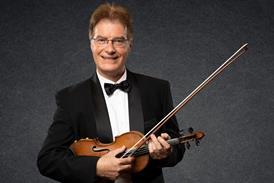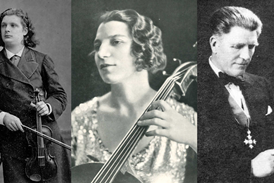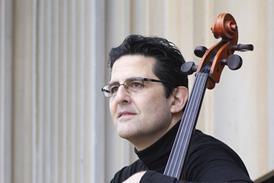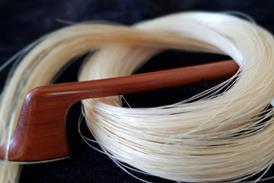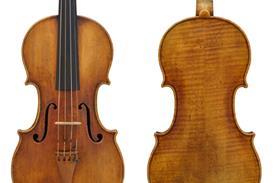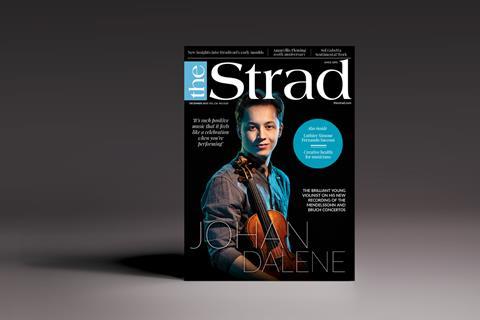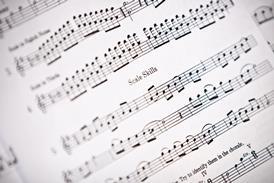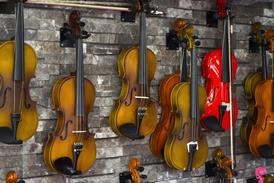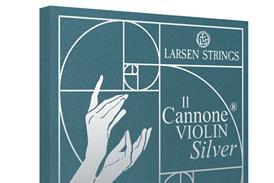All Historical articles – Page 9
-
 News
NewsEuropa Galante to play on matched string ensemble
The concert, taking place on 21 November, features eleven instruments all made by luthier Renato Scrollavezza
-
 News
NewsViolin maker Tetsuo Matsuda dies aged 77
Born in Japan, the luthier lived in Chicago, US, for four decades
-
 Focus
FocusThe Strad Calendar 2023: 1784 Guadagnini violin
One of the last instruments made by the luthier, who died in 1786, the violin has a miraculously intact varnish and an excellent soprano sound with great projection
-
 Focus
FocusThe thief, his wife and the ‘Huberman’ Strad
The ‘Gibson, Huberman’ Stradivari now owned by Joshua Bell has a history worthy of a blockbuster thriller
-
 Premium ❘ Feature
Premium ❘ FeatureFrançois Nicolas Voirin: The style and substance of a pivotal bow maker
Matt Wehling on Voirin’s artistic and technical advances, which were implemented by most all French makers and paved the way for makers such as Lamy, Sartory and E.A. Ouchard
-
 Focus
FocusThe Strad Calendar 2023: c.1585 Gasparo da Salo double bass
The wood used for the front came from a 250-year-old tree, making parts of this beautiful instrument around 700 years old
-
 Premium ❘ Feature
Premium ❘ Feature‘The scent of fraud hangs about him’ - The Brothers Abell: Secrets and Lies
Follow the lives of two brothers embroiled scandals, lies and violins
-
 Video
VideoMy Space: Anna, Dixie and Roland Huthmaker
The trio of violin makers give a tour of their Atlanta workshop, as featured in the November 2022 issue
-
 Focus
FocusThe Strad Calendar 2023: 1743 ‘Carrodus’ Guarneri ‘del Gesù’ violin
’It is said, by the way, to have belonged to Paganini, and to have been gambled away by him’ - John Tiplady Carrodus
-
 Focus
FocusPhoto gallery: 300 years young – Stradivari’s decorated ‘Rode’ violin
The 1722 instrument will be performed in concert at Oxford’s Ashmolean Museum on 20 October, to mark its 300th anniversary
-
 Focus
FocusThe Strad Calendar 2023: 1729 Guarneri ‘filius Andreae’ cello
One of only two cellos in the world that also bears the handiwork of Guarneri ‘del Gesù’
-
 Focus
FocusThe Strad Calendar 2023: 1714 Guarneri ‘filius Andreae’ violin
Formerly owned by Isolde Menges, this instrument might also bear the hand of Guarneri ‘del Gesù’
-
 Premium ❘ Feature
Premium ❘ FeatureThe Viennese double bass: The long pattern
In the 18th and 19th centuries, double basses made in Vienna had distinctive shapes and characteristics that gave them tremendous sound quality.
-
 Focus
FocusThe Strad Calendar 2023: 1728/29 Antonio Stradivari violin
The first ever Stradivari instrument to be played within an Australian orchestra
-
 Premium ❘ Feature
Premium ❘ FeatureIn Focus: A c.1815 double bass by Thomas Dodd
Stefan Krattenmacher details an instrument by the English maker
-
 Premium ❘ Feature
Premium ❘ FeatureMaking Matters: Artistic licence and the ‘true violin’
Is our understanding of violin history too heavily influenced by the old Italians?
-
 Premium ❘ Feature
Premium ❘ FeatureCarlo Bergonzi 1735 ‘Baron Knoop’ violin: The Heir Apparent
Andrea Zanrè shows how his ‘Baron Knoop’ violin of 1735 displays an unmistakable personality despite the influence of Stradivari and his contemporaries
-
 Focus
FocusHow the violin trade has changed since the Queen’s accession
In this article from 2012, Philip Kass examines how everything from manufacturing to trade in the Far East have all changed during the Queen’s reign
-
 News
News‘With this, I’ve fulfilled a lifelong dream’: violinist David Garrett on his 1736 Guarneri ’del Gesù’
Having bought the violin at auction in June, the German superstar has now also created the Guarneri ’del Gesù’ Club
-
 Premium ❘ Feature
Premium ❘ FeatureInternational lutherie schools: All round learning
Peter Somerford speaks to teachers from seven violin making schools to find out the options for young aspiring luthiers

